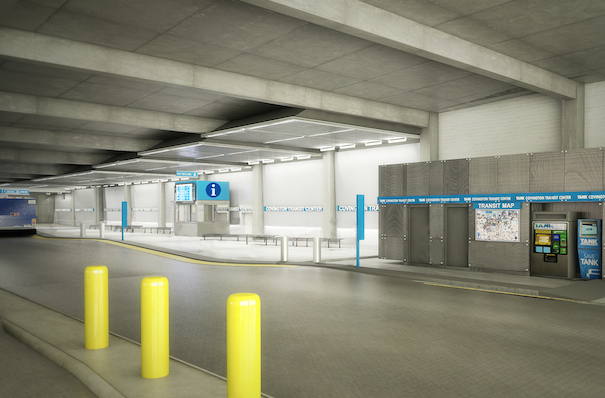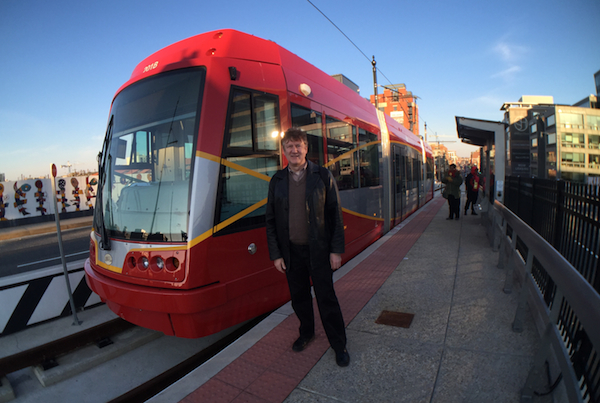By John Fox
NKY Thrives
In a simpler time, public transportation connected communities by moving residents from Point A to Point B quickly and cheaply.
In today’s fast-paced world, public transit — like most government-funded services — is now expected to play a major role in economic development efforts. Suburban employers are trying to attract and retain talent by making jobs more accessible via targeted bus service, while urban centers are adding streetcars and bikes to attract younger residents and the apartments, restaurants and stores that follow them.
All the while, people across Greater Cincinnati (and the country) continue to drive their cars — often alone — and clog the highways and byways, creating more and more traffic delays, air pollution and frustration.
Back in 2013, the Transit Authority of Northern Kentucky (TANK) developed the Transit Network Study to look at NKY’s public transportation systemthrough the prism of existing and future travel patterns, population density and employment centers. The resulting plan pushed short-term service changes and a long-term transit vision.
With a number of changes now implemented and others on the way, TANK General Manager Andrew Aiello is optimistic that the agency has helped position Northern Kentucky for growth and success.
“Job and population centers move all the time, so it can be difficult to keep up with the changes,” he says. “I think we’re very responsive to the community’s needs, though of course we still have a long way to go.”
Meanwhile, hoping to strike while the streetcar iron is hot, a group of Newport residents is looking to bring a spur of the Cincinnati Streetcar across the river as one more transit tool to drive economic development.
‘I’m proud that we’re so responsive’
The Network Study Plan has tried to simplify the vision behind TANK’s complex system timetable and planning process by focusing on a few core goals: Service should operate at regular intervals, and routes should be symmetrical, operate along a direct path and serve well-defined markets.
As a result, Aiello says most of TANK’s attention has been trained on high-capacity traffic corridors linking work and residential centers.
Route #1 along the Dixie Highway corridor to Florence — TANK’s busiest route — was upgraded earlier this year with new state-of-the-art shelters and signage and a hub at Florence Mall. Planning will begin soon for similar projects along Madison Avenue in Covington and Monmouth/York Streets in Newport.
Breaking from the traditional hub-and-spoke system radiating south from Cincinnati, Covington and Newport, TANK opened the east-west 35X route to link Northern Kentucky University and Florence Mall, crossing Boone, Kenton and Campbell counties. Ridership is up 13 percent over the past year, making it one of TANK’s fastest growing routes.
Ian Budd tried the new Washington D.C. streetcar while visiting federal officials earlier this year[/caption]Service and frequency have been increased on the 39X and 40X express routes to the Hebron industrial area, where employment growth has already surpassed what the Transit Network Study forecasted.
Finally, TANK is working with NKU officials to establish a campus hub to serve as a prominent transfer point for Campbell County routes and with Cincinnati Northern Kentucky International Airport officials on expanding its activity there.
“We know that demands for transit between the urban core and the suburban industrial parks are increasing each year,” Aiello says. “Additionally, there is an increasing need to more directly and efficiently connect employment opportunities in Northern Kentucky to people living in our community. We’re studying the different ways that we might provide more flexible service that meets the needs of a 7-day-a-week, 24-hour-a-day workforce.”
One way TANK explores service options is to test new routes and schedules with funding from regional businesses. The partnerships allow TANK to gauge rider demand while a business sees first-hand how specific bus service might benefit its employees.
“Companies will underwrite pilot programs to serve new areas, and some become permanent routes while others stop after the pilot,” Aiello says. “We have a very open and collaborative approach with Northern Kentucky employers, and I’m proud that we’re so responsive.”
Two other high-profile projects — one almost finished and the other just in the planning stages — will test TANK’s responsiveness and imagination.
The Covington Transit Center, which Aiello calls “the cornerstone of TANK’s system,” is being updated with better lighting, improved waiting areas and clearer passenger information. The downtown facility will be completed soon.
And TANK is exploring a “bus on shoulder” pilot program along I-471 to be used during times of heavy traffic congestion. It would allow a bus to drive around stalled traffic on highway shoulders or managed lanes.
“While the Brent Spence Bridge project goes unfunded, traffic congestion along the I-71/75 corridor continues to be troublesome for our community,” Aiello says. “TANK’s on-time performance and reliability, as the majority of our express service uses the highways to access downtown Cincinnati, is particularly affected by the congestion. Prioritizing mass transit in areas with excess traffic not only helps incentivize transit ridership and other shared rides but also reduces traffic and pollution by taking more single occupancy vehicles off the road.”
Ultimately, he says, TANK will follow where the NKY community wants its public transportation system to go.
“We educate on and execute the plans that are developed by the whole community, but we’re not policy leaders,” Aiello says. “We have to hear that there’s a consensus around what the community wants from TANK.”
‘We’ve found more support than we expected’
A consensus is starting to form in Newport, at least in certain circles, about returning streetcar service to Northern Kentucky and attracting the kind of economic development action that currently surrounds the Cincinnati Streetcar.
Ian Budd, who runs ICB Audio and Video in Cincinnati and has lived in Newport since 1979, chairs the Northern Kentucky Streetcar Committee. He and other supporters are convinced that a spur from Cincinnati’s streetcar line across to Newport and eventually to Covington will benefit both sides of the river.
“Real progress in Cincinnati is finally coming to fruition as the streetcar gets ready to debut (on Sept. 9),” Budd says. “Most sensible people see that it will be more successful if it’s expanded up the hill to the UC area. A longer route that also includes Northern Kentucky will serve more people, give the line more scale and make it more attractive to potential users.”
The Northern Kentucky Streetcar Committee envisions that a connection from Cincinnati’s streetcar line at Second/Third and Main Streets in front of Great American Ball Park would cross the Taylor-Southgate Bridge into west Newport. That area is poised for huge economic growth, with the AA Highway (Rt. 9) extension set to terminate near the proposed Ovation residential/office/retail complex.
Budd and Newport City Commissioner Beth Fennell visited Washington, D.C. in February to make contacts, get feedback on the idea and learn about next steps. They met with officials from the Department of Transportation, the Federal Transportation Administration and the offices of Sen. Mitch McConnell, Sen. Rand Paul and Rep. Thomas Massie
Ian Budd tried the new Washington D.C. streetcar while visiting federal officials earlier this year[/caption]The Department of Transportation suggested that the group apply for a DOT grant to do a proper feasibility study on the streetcar extension, which Budd says the committee has done. They’ll find out in about six months if they get the grant.
A transit project like this streetcar line is usually funded 80 percent by the federal government and 20 percent from local sources, Budd says, and so he and his committee have been meeting with elected officials, corporate leaders, neighborhood groups and other stakeholders to explain their concept and seek support.
Budd says he’s been pleased that so far, unlike the years of political bickering that threatened to derail the Cincinnati Streetcar project, the NKY streetcar concept has been warmly received.
“We’ve had no negative responses at all, no anti-growth rhetoric like in Cincinnati,” he says. “I’m not sure why, but we seem to work together well in Newport and Campbell County. You’re never going to get 100 percent buy-in on anything, but we’ve found more support than we expected.”
On the official planning front, OKI has included phase 1 of the Northern Kentucky Streetcar on the recommended NKY projects list in its 2040 Regional Transportation Plan. TANK is waiting to see if the broader community embraces the concept.
“TANK is aware of public support for the Northern Kentucky Streetcar because we’ve met with them and explained our project,” Budd says. “Now we need to do a full feasibility study to prove its validity.”
TANK didn’t include a streetcar or any type of rail among its long-range goals in the current Network Study Plan, Aiello says, but he’ll continue to listen to this discussion and offer technical expertise as needed.
“Ultimately, our community and our elected officials will decide if this or other rail projects become a reality in NKY,” he says. “Regardless, it’s great to hear yet another discussion about how public transit can encourage economic development and improve access to jobs.”

























